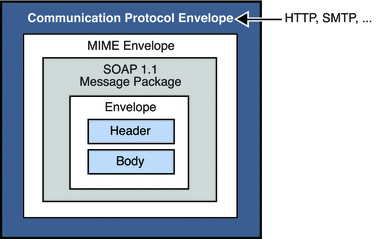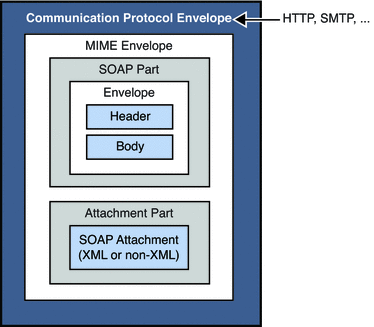SOAP Packaging Models
The SOAP specification describes two models of SOAP messages: one that is encoded entirely in XML and one that allows the sender to add an attachment containing non-XML data. You should look over the following two figures and note the parts of the SOAP message for each model. When you use SAAJ to define SOAP messages and their parts, it will be helpful for you to be familiar with this information.
Figure 5–3 shows the SOAP model without attachments. This package includes a SOAP envelope, a header, and a body. The header is optional.
Figure 5–3 SOAP Message Without Attachments

When you construct a SOAP message using SAAJ, you do not have to specify which model you’re following. If you add an attachment, a message like that shown in Figure 5–4 is constructed; if you don’t, a message like that shown in Figure 5–3 is constructed.
Figure 5–3 shows a SOAP Message with attachments. The attachment part can contain any kind of content: image files, plain text, and so on. The sender of a message can choose whether to create a SOAP message with attachments. The message receiver can also choose whether to consume an attachment.
A message that contains one or more attachments is enclosed in a MIME envelope that contains all the parts of the message. In SAAJ, the MIME envelope is automatically produced whenever the client creates an attachment part. If you add an attachment to a message, you are responsible for specifying (in the MIME header) the type of data in the attachment.
Figure 5–4 SOAP Message with Attachments

- © 2010, Oracle Corporation and/or its affiliates
